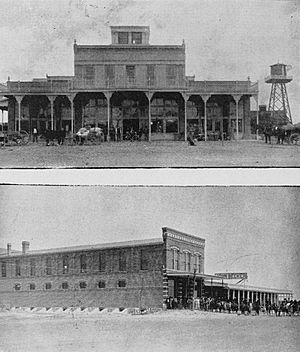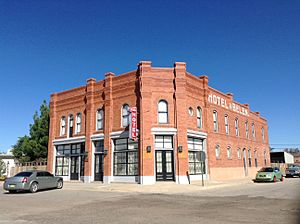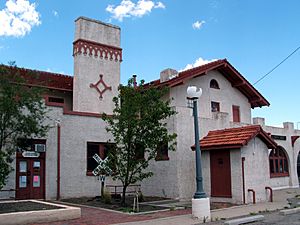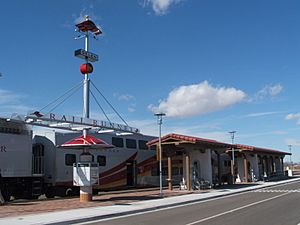Belen, New Mexico facts for kids
Quick facts for kids
Belén, New Mexico
|
||
|---|---|---|
|
||
| Nicknames:
The Hub City, B-Town
|
||
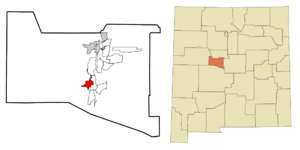
Location of Belen, New Mexico
|
||
| Country | United States | |
| State | New Mexico | |
| County | Valencia | |
| Settled | 1740 | |
| Incorporated | 1918 | |
| Government | ||
| • Type | Mayor-Council | |
| Area | ||
| • Total | 19.08 sq mi (49.41 km2) | |
| • Land | 19.05 sq mi (49.35 km2) | |
| • Water | 0.02 sq mi (0.06 km2) | |
| Elevation | 4,810 ft (1,470 m) | |
| Population
(2020)
|
||
| • Total | 7,360 | |
| • Density | 386.27/sq mi (149.14/km2) | |
| Demonym(s) | Belenite | |
| Time zone | UTC-7 (Mountain (MST)) | |
| • Summer (DST) | UTC-6 (MDT) | |
| ZIP code |
87002
|
|
| Area code(s) | 505 | |
| FIPS code | 35-06480 | |
| GNIS ID | 2409814 | |
Belén (pronounced "buh-LIN") is a city in New Mexico, United States. Its name means "Bethlehem" in Spanish. It is the second largest city in Valencia County, after Los Lunas. In 2020, about 7,360 people lived there.
Belén is often called the "Hub City." This nickname came about because the Atchison, Topeka and Santa Fe Railway built an important train line through the city in 1907. Belén is located near the center of New Mexico. It is a key place for transportation, with access to trains, Interstate Highway 25, and the only public airport in Valencia County.
The city is about 35 miles south of Albuquerque, at the southern edge of the Albuquerque Metropolitan Statistical Area.
Contents
History of Belén
Belén was started in 1740 by a group of settlers led by Diego Torres and Antonio Salazar. They called it Nuestra Señora de Belén, which means "Our Lady of Bethlehem." Some of the first families to settle here were genízaros. These were Native Americans who had been servants or slaves of the colonists. They moved to places like Belén to get land and help protect the colony's borders from Apache raiders.
Belén was the first of many such settlements. By 1744, 40 families lived there. Spanish and mestizo families also moved to Belén. In 1760, the Spanish government built a fort in Belén because it was an important location. By the 1790s, Belén had a town center called Plaza Vieja (Old Town). It grew to have a population of 1,695 people. A Catholic church was also built in 1793.
By the mid-1800s, Belén grew beyond Old Town and started a new area called New Town. In 1853, people in Old Town and New Town argued about where to build a new Catholic church. Eventually, the old church was left behind, and a new one was built in New Town. In 1910, the old church's ruins were removed, and the materials were used to pave Becker Avenue, a main street in New Town.
For nearly 30 years, from 1846 to 1875, people in Valencia County argued about where the county seat (the main government town) should be. Belén held the county seat for a short time in 1872, but lost it two years later. Finally, in 1875, Los Lunas became the county seat, and it still is today.
In 1862, during the Civil War, Belén was briefly taken over by 400 Confederate soldiers. However, the Confederate army left New Mexico by the summer of that year.
In 1880, the Atchison, Topeka, and Santa Fe Railway built a rail line through Belén. In 1884, the town of Belén was officially established. Around 1900, a local businessman named John Becker planned out the town's streets. He designed Belén with a grid pattern, centered around two main avenues: Becker Avenue and Dalies Avenue.
A very important event for Belén was the completion of the Belén Cutoff in 1907. This new rail line connected Amarillo, Texas, with Belén. Before this, trains had to use a very steep path called Raton Pass. The Belén Cutoff made it much easier for trains to travel across the United States. Belén became a major train hub with a large roundhouse (where trains are repaired) and a classification yard (where trains are sorted). Today, Belén is still a big refueling stop for the BNSF Railway. About 110 trains pass through Belén every day on the Southern Transcon route.
Belén officially became a city in 1918.
In 1927, a pilot from Belén named Arthur C. Goebel won a famous air race. He flew nonstop from the United States mainland to Hawaii in his plane, the Woolaroc. Many planes crashed, but Goebel landed first after 26 hours and 17 minutes, winning $25,000!
In July 1945, the world's first atomic bomb was transported through Belén in pieces. It was on its way to the Trinity test site. There's a local story that the military and scientists escorting the bomb might have stopped at Roy's Cafe in downtown Belén, which had special security clearance.
In 1950, a Belén restaurant owner named William F. Beavers invented a machine to slice potatoes into waffle shapes. He was granted a patent for his "slicing machine" two years later. These waffle fries could be enjoyed with Belén's own "Hub City" soda pop, made by the Belén Bottling Co.
Geography
Belén is located in the Rio Grande Valley on the west side of the Rio Grande river. The city has a total land area of about 4.7 square miles (12.2 square kilometers).
Climate
Belén has a dry, semi-desert climate.
| Climate data for Belen, New Mexico | |||||||||||||
|---|---|---|---|---|---|---|---|---|---|---|---|---|---|
| Month | Jan | Feb | Mar | Apr | May | Jun | Jul | Aug | Sep | Oct | Nov | Dec | Year |
| Mean daily maximum °F (°C) | 50.7 (10.4) |
57.5 (14.2) |
63.9 (17.7) |
74.4 (23.6) |
83.7 (28.7) |
93.1 (33.9) |
95.2 (35.1) |
92.3 (33.5) |
86.1 (30.1) |
75.5 (24.2) |
61.5 (16.4) |
51.2 (10.7) |
73.8 (23.2) |
| Mean daily minimum °F (°C) | 18.6 (−7.4) |
23.1 (−4.9) |
29.5 (−1.4) |
37.9 (3.3) |
46 (8) |
54.6 (12.6) |
61.8 (16.6) |
59.7 (15.4) |
50.7 (10.4) |
38.9 (3.8) |
26.3 (−3.2) |
19.9 (−6.7) |
38.9 (3.9) |
| Average precipitation inches (mm) | 0.3 (7.6) |
0.4 (10) |
0.4 (10) |
0.3 (7.6) |
0.3 (7.6) |
0.7 (18) |
1.4 (36) |
1.3 (33) |
0.9 (23) |
1.0 (25) |
0.2 (5.1) |
0.5 (13) |
7.6 (190) |
| Average precipitation days (≥ 0.01 in) | 2 | 2 | 3 | 2 | 2 | 2 | 6 | 7 | 4 | 3 | 2 | 2 | 37 |
| Source: NOAA | |||||||||||||
Cityscape and Historic Buildings
Belén's downtown area is along Becker and Dalies avenues, near the BNSF rail yard. Many buildings in downtown Belén date back to the early 1900s when the railroad arrived.
The Belen Hotel and Central Hotel on Becker Avenue are two-story buildings. They were built to house railroad workers and travelers in the early 1900s. Today, the Belen Hotel is a private home and art gallery. The Central Hotel has been updated with a home upstairs and an event space downstairs.
Old City Hall, also on Becker Avenue, was built in 1938. It used to be the city hall and fire department. This two-story building was made from terron, a material similar to adobe.
The Belén Harvey House is right next to the BNSF rail yard. This two-story building opened in 1907. It provided food and lodging for railroad workers and passengers. The original Belén train depot is next to the Harvey House.
The Scholle building, at Main Street and Becker Avenue, is a special building. It was designed like a Swiss chalet and has over eight miles of rail built into its walls!
The Oñate Theater on Dalies Avenue was built in the early 1900s. It used to show many popular movies.
Population Information
| Historical population | |||
|---|---|---|---|
| Census | Pop. | %± | |
| 1920 | 1,306 | — | |
| 1930 | 2,116 | 62.0% | |
| 1940 | 3,038 | 43.6% | |
| 1950 | 4,495 | 48.0% | |
| 1960 | 5,031 | 11.9% | |
| 1970 | 4,823 | −4.1% | |
| 1980 | 5,617 | 16.5% | |
| 1990 | 6,547 | 16.6% | |
| 2000 | 6,901 | 5.4% | |
| 2010 | 7,269 | 5.3% | |
| 2020 | 7,360 | 1.3% | |
| U.S. Decennial Census | |||
In 2000, Belén had 6,901 people living in 2,596 households. About 34.8% of households had children under 18. The average household had 2.61 people.
The population was spread out by age:
- 28.8% were under 18
- 9.6% were 18 to 24
- 25.5% were 25 to 44
- 21.0% were 45 to 64
- 15.1% were 65 or older
The average age in Belén was 35 years.
Culture and Events
Annual Festivals and Events
Belén hosts several fun events each year:
- The St. Patrick's Day Balloon Rallye happens the Saturday before St. Patrick's Day.
- The All-American Fourth of July is celebrated around July 4.
- Rio Abajo Days takes place on the last Saturday in September.
- The Miracle on Main Street Festival and Electric Light Parade is held the Saturday after Thanksgiving.
The Hispano Matanza is held every year in Belén on the last Saturday in January. It's known as the world's largest matanza, which is a Spanish-style barbecue. This tradition involves cooking 45 pigs and serving free food, like chicharrones, to over 10,000 people. All the money raised goes to scholarships for local college students.
The Our Lady of Belen Fiestas have been celebrated for over 230 years. This event happens for one weekend in mid-August. Thousands of people come to Belén for religious services and to enjoy a carnival. It's also when Valencia County's green chile is ready for harvest, often used to make a "Fiesta Burger."
"Follow the Star" is a December celebration of the birth of Jesus Christ. It honors Belén's Christian heritage (since Belén means Bethlehem). The event starts in historic downtown Belén and ends with the lighting of the Star of Bethlehem on the city's water tower. Along the way, churches tell the Christmas story with live characters and music.
Museums
Belén has the only Harvey House Museum in New Mexico. The Santa Fe railroad reached Belén in 1880. In 1908, the Belén Cutoff opened, bringing many more trains through the city. To serve the passengers, the railroad built a Harvey House restaurant in 1910. It was the 86th restaurant in the Fred Harvey chain. It had a large lunchroom, a dining room, a bakery, and rooms upstairs for the "Harvey Girls" who served the meals.
Today, this Harvey House is a museum. It displays items from the Harvey House and the Santa Fe Railway. It also has exhibits about early businesses and people in Belén. The Belén Harvey House is the official railroad museum of New Mexico. It is also a part of the Belén Public Library.
Parks and Outdoor Attractions
Belén has nine parks and is home to the Valencia County Fairgrounds.
The Valencia County Fairgrounds are on the north side of Belén. They have two rodeo areas and a restaurant and dance hall. Every August, the fairgrounds host the Valencia County Fair, with a parade down Main Street.
Eagle Park is near I-25 and Belén High School. It's a large park with soccer fields, baseball fields, tennis courts, and an outdoor basketball court. It also has a community center with a weight room and an indoor basketball court.
Historic Anna Becker Park in downtown Belén is named after the wife of John Becker, an important businessman. This park used to be a pond where people ice skated in winter. It now has a sand volleyball pit, basketball court, and a historic gazebo.
Doodlebug Park features a restored Doodlebug rail car. These Doodlebugs used to take Belén residents to Albuquerque in the early 1900s. The Doodlebug at the park was restored by the film crew of The Last Stand, starring Arnold Schwarzenegger, which was filmed nearby.
Belén also has Sen. Willie M. Chavez State Park, next to the Rio Grande. This park has walking trails and picnic areas. It's used for a yearly ham radio event and a fishing derby at the acequia (irrigation canal) that runs through the park.
Other parks in Belén include El Corazon de Belen Garden Park, Jose Gallegos Park, Rosedale Park, Ross Park, and Welcome Park.
Media
- The Valencia County News-Bulletin is a weekly newspaper for Valencia County.
- KBNM-LP is a radio station in Belén that plays oldies music.
- Hub City News is an online news source that focuses on Belén and Valencia County.
Education
Most of Belén is part of the Belen Consolidated Schools district. This district includes:
- Two high schools: Belén High School and Infinity High School
- One middle school
- Seven elementary schools
- An alternative high school
- A family school for home-schooled students
Small parts of Belén are in the Los Lunas Public Schools district.
For private education, Our Lady of Belen Catholic Church runs St. Mary's Catholic School. Calvary Chapel Rio Grande Valley runs Canon Christian Academy.
For higher education, Belén residents can attend the University of New Mexico Valencia Campus in Tome or the main University of New Mexico campus in Albuquerque.
Transportation
Roads
Interstate 25 forms Belén's western border. New Mexico Highway 314 and Highway 309 also cross through the city.
Airport
Belen Regional Airport is the only public airport in Valencia County. It is mainly used for general aviation, including business jets, flight training, skydiving, and crop dusting. Several aviation businesses are located at the airport.
Rail
The BNSF Railway has important east-west and north-south train routes that cross through Belén. The New Mexico Rail Runner Express is a commuter train service that has a station in Belén. It takes passengers to and from Albuquerque and Santa Fe daily.
The BNSF Rail Yard in Belén is a major division point for the Southern Transcon train route. This means it's a key place where trains are sorted and crews change.
Bicycle Routes
New Mexico Bike Route 1 goes through Belén on Reinken Avenue. This route connects Belén with Bernardo, which is about 17.5 miles south.
Notable people
People born in Belén:
- Art Aragon (1927-2008), a boxer
- Bartolomé Baca (1767-1834), a governor
- Gregory A. Baca (born 1971), a politician and Gulf War veteran
- Joe Baca (born 1947), a politician
- Tara Calico (born 1969; status unknown), a missing person
- Gloria Castillo (1933-1978), an actress
- Richard Carrillo (born 1967), a politician
- Tony Gabaldon (1930-1998), a school principal and Arizona state senator
- Damon Gray, a singer
- Clinton Harden (born 1947), a politician
- Mike Nesbitt, a football coach
- Joshua A. Sanchez (born 1981), a businessman
- Michael S. Sanchez (born 1950), a politician
People now living in Belén:
- Judy Chicago, an artist and feminist
See also
 In Spanish: Belén (Nuevo México) para niños
In Spanish: Belén (Nuevo México) para niños




